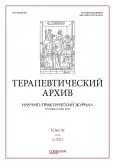The prevalence of sarcopenia in patients with rheumatological pathology
- Authors: Lavrishcheva I.V.1, Jakovenko A.A.2, Rumyantsev A.S.3
-
Affiliations:
- Almazov National Medical Research Centre
- Pavlov First Saint Petersburg State Medical University
- Saint Petersburg State University
- Issue: Vol 93, No 5 (2021)
- Pages: 568-572
- Section: Original articles
- URL: https://journals.rcsi.science/0040-3660/article/view/71509
- DOI: https://doi.org/10.26442/00403660.2021.05.200788
- ID: 71509
Cite item
Full Text
Abstract
Aim. To assess the prevalence of sarcopenia in rheumatological patients.
Materials and methods. 317 patients with rheumatological pathology were examined, among them 201 women and 116 men, the age of patients ranged from 21 to 58 years, the average age at the time of inclusion of patients in the study was 41.1±7.3 years. Sarcopenia was diagnosed using the method recommended by The European Working Group on Sarcopenia in Older People 2.
Results. The frequency of occurrence of a decrease in the appendicular skeletal muscle mass to the appendicular skeletal muscle mass index was 31.2% (99 patients), a decrease in muscle strength according to the wrist dynamometry was observed in 44.5% (141) patients, low skeletal muscle performance according to the results NIH Toolbox 4 Meter Walk Gait Speed Test in 42.8% (135) patients. The prevalence of suspected sarcopenia (probable sarcopenia) was 13.3% (42 patients) and sarcopenia, including severe 31.2% (99) patients. Statistically significant differences were obtained between groups of patients depending on the duration of rheumatological disease and the prevalence of sarcopenia (χ2=19.328; p=0.001).
Conclusion. Sarcopenia occurs in a third of hospitalized rheumatological patients.
Keywords
Full Text
##article.viewOnOriginalSite##About the authors
Iuliia V. Lavrishcheva
Almazov National Medical Research Centre
Email: lavrischeva@gmail.com
ORCID iD: 0000-0002-3073-2785
врач-ревматолог
Russian Federation, Saint PetersburgAleksandr A. Jakovenko
Pavlov First Saint Petersburg State Medical University
Author for correspondence.
Email: leptin-rulit@mail.ru
ORCID iD: 0000-0003-1045-9336
канд. мед. наук, доц. каф. нефрологии и диализа
Russian Federation, Saint PetersburgAleksandr S. Rumyantsev
Saint Petersburg State University
Email: rash.56@mail.ru
ORCID iD: 0000-0002-9455-1043
д-р мед. наук, проф. каф. факультетской терапии мед. фак-та
Russian Federation, Saint PetersburgReferences
- Blau HM, Cosgrove BD, Ho ATV. The central role of muscle stem cells in regenerative failure with aging. Nat Med. 2015;21:854-62. doi: 10.1038/nm.3918
- Järvinen TA, Järvinen M, Kalimo H. Regeneration of injured skeletal muscle after the injury. Muscles Ligaments Tendons J. 2014;3(4):337-45.
- Ryall JG, Schertzer JD, Lynch GS. Cellular and molecular mechanisms underlying age-related skeletal muscle wasting and weakness. Biogerontology. 2008;9:213-28. doi: 10.1007/s10522-008-9131-0
- Turner NJ, Badylak SF. Regeneration of skeletal muscle. Cell Tissue Res. 2012;347:759-74. doi: 10.1007/s00441-011-1185-1187
- Cruz-Jentoft AJ, Bahat G, Bauer J, et al. Sarcopenia: revised European consensus on definition and diagnosis. Age Ageing. 2019;48(1):16-31. doi: 10.1093/ageing/afy169
- Cruz-Jentoft AJ, Sayer AA. Sarcopenia. Lancet. 2019;393(10191):2636-46. doi: 10.1016/S0140-6736(19)31138-9
- Mijnarends DM, Koster A, Schols JM, et al. Physical activity and incidence of sarcopenia:the population-based AGES-Reykjavik Study. Age Ageing. 2016;45(5):614-20. doi: 10.1093/ageing/afw090
- Cederholm T, Jensen GL, Correia M, et al. GLIM criteria for the diagnosis of malnutrition – A consensus report from the global clinical nutrition community. Clin Nutr. 2019;38(1):1-9. doi: 10.1016/j.clnu.2018.08.002
- Ogbechi J, Clanchy FI, Huang YS, et al. IDO activation, inflammation and musculoskeletal disease. Exp Gerontol. 2020;131:110820. doi: 10.1016/j.exger.2019.110820
- Krajewska-Włodarczyk M, Owczarczyk-Saczonek A, Placek W. Changes in body composition and bone mineral density in postmenopausal women with psoriatic arthritis. Reumatologia. 2017;55:215-21. doi: 10.5114/reum.2017.71627
- Torii M, Hashimoto M, Hanai A, et al. Prevalence and factors associated with sarcopenia in patients with rheumatoid arthritis. Mod Rheumatol. 2019;29(4):589-95. doi: 10.1080/14397595.2018.1510565
- El Maghraoui A, Ebo’o FB, Sadni S, et al. Is there a relation between pre-sarcopenia, sarcopenia, cachexia and osteoporosis in patients with ankylosing spondylitis? BMC Musculoskelet Disord. 2016;17:268. doi: 10.1186/s12891-016-1155-z
- Ngeuleu A, Allali F, Medrare L, et al. Sarcopenia in rheumatoid arthritis: Prevalence, influence of disease activity and associated factors. Rheumatol Int. 2017;37:1015-20. doi: 10.1007/s00296-017-3665-x
- Sergi G, De Rui M, Veronese N, et al. Assessing appendicular skeletal muscle mass with bioelectrical impedance analysis in free-living Caucasian older adults. Clin Nutr. 2015;34(4):667-73. doi: 10.1016/j.clnu.2014.07.010
- Human Energy Requirements: Report of a Joint FAO/WHO/UNU Expert Consultation. Available at: http://www.fao.org/3/a-y5686e.pdf. Accessed: 05.11.2018.
- Barone M, Viggiani MT, Anelli MG. Sarcopenia in Patients with Rheumatic Diseases: Prevalence and Associated Risk Factors. J Clin Med. 2018;7(12):504. doi: 10.3390/jcm7120504
- Polyzos SA, Margioris AN. Sarcopenic obesity. Hormones (Athens). 2018;17(3):321-31. doi: 10.1007/s42000-018-0049-x
- Stenholm S, Harris ТВ, Hantanen T, et al. Sarcopenic obesity: definition, cause and consequences. Curr Opin Clin Nutri Metab Care. 2008;11(6):693-700. doi: 10.1097/MCO.0b013e328312c37d
- Zamboni M, Mazzali G, Fantin F, et al. Sarcopenic obesity: a new category of obesity in the elderly. Nutr Metab Cardiovasc Dis. 2008;18(5):388-95. doi: 10.1016/j.numecd.2007.10.002.
Supplementary files









